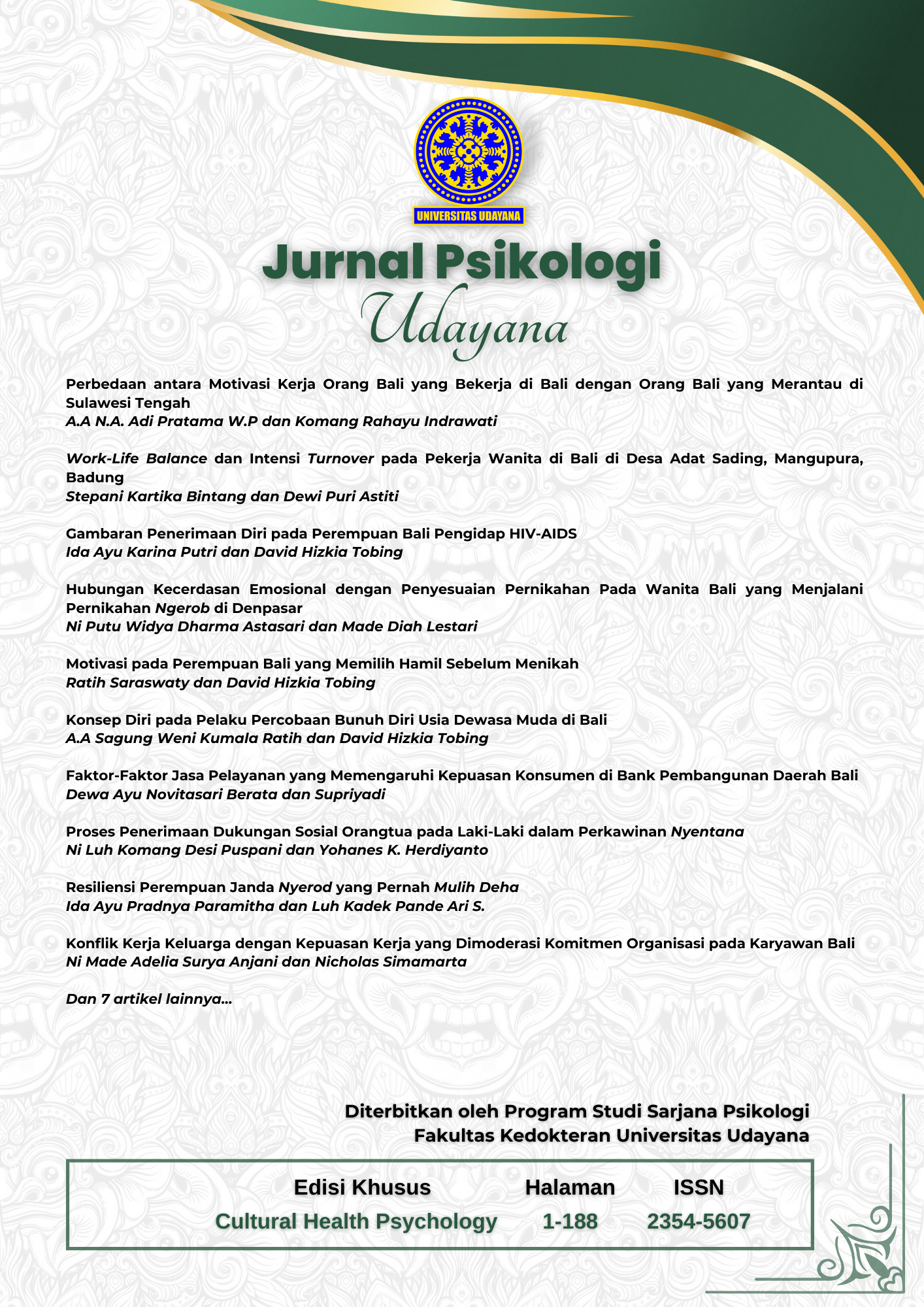RESILIENSI PEREMPUAN JANDA NYEROD YANG PERNAH MULIH DEHA
Abstract
Marriage in Balinese society is closely related to the existing Wangsa in Bali. According to different marriage of Wangsa in Bali, women’s Wangsa will be dropped to follow her husband’s Wangsa which is known as nyerod. Living a family life can’t be separated from household matters that can lead into the end of marriage that can be caused by divorce or death of the husband. For nyerod widow who return back to her bajang house and accepted by the biological family, the status becomes mulih deha. Individuals who have failed in household, some were able to get through stressful situations, but not a little were difficult to pass it. Individuals who are able to respond in a way that is healthy and productive when facing adversity or trauma called resilience. Based on these explanation, this study aim to know the resilience nyerod widow who have hadmulih deha.
This study use qualitative research method with case study approach. Respondents in this study are two persons. The techniques of collecting the data were interviews and observation in two nyerod's widow that already mulih deha. Data analysis techniques through three stages, namely open coding, axial coding and selective coding.
The results of this study indicated there were occurs twice pressing conditions, breakdown into eight phases, namely adverse events (nyerod), succumbing, survival, adverse events (loss of a spouse), succumbing, survival, recovery, and thriving. Besides that some of internal factors that can support resilient are motivation and hope, from external factors are children, family and social.
Keywords: resilience, widow, nyerod, mulih deha
Downloads
References
Anggreni, L. P. (2004). Perceraian dan perlindungan terhadap anak.Diunduh dari:http://lbh-
bali.blogspot.com/2011/09atauprceraian-dan-perlindungan-terhadap_09.htmltanggal 25 Oktober 2013
Ardhianita,I., & Andayani, B. (2005). Kepuasan pernikahan ditinjau dari berpacaran dan tidak berpacaran. Jurnal Psikologi, 32 (2), 101-111
Atmaja, I. D., Atmaja, M. W., Dyatmikawati, P., Windia, I. W., Sudantra, I. K., Astiti, T. I., et al. (2009). Warna-warni pemikiran tentang adat dan budaya bali. Bali: Fakultas Hukum Universitas Udayana.
Atmaja, Jiwa. (2008). Bias gender: perkawinan terlarang pada masyarakat bali. Bali: Udayana University Press
Badan Pusat Statistik. (2011). Persentase Penduduk Menurut Status erkawinan dan Jenis Kelamin, Provinsi Bali 2011. Denpasar: Badan Pusat Statistik Provinsi Bali
Carver, C. S. (1998). Resilience and thriving: issues, models, and linkages. Jorunal of Social Issues, 54 (2), pp. 245-266
Creswell, John W. (1998). Qualitative inquiry and research design: choosing among five traditions. Thousand Oaks: Sage Publication
Creswell, John W. (2009). Research design: qualitative, quantitative, and mixed methods approaches. Los Angeles: Sage Publication
Creswell, John W. (2012). Research design: pendekatan kualitatif, kuantitatif, dan mixed. Yogyakarta: Pustaka Belajar
Grotberg, E.H. (1999). Tapping tour inner strength. How to find the resilience to deal with anything. Oakland: New Harbinger Publications,Inc.
Hurlock, E. B. (2006). Psikologi perkembangan suatu pendekatan sepanjang rentang kehidupan (edisi kelima). Jakarta: Erlangga.
Kaelan, H. (2012). Metode penelitian kualitatif interdisipliner. Yogyakarta : Paradigma
Maharini, K. (2013). Permasalahan pernikahan beda wangsa dan agama. Diunduh dari: Http://Ayu-Maha.Blogspot.Com/2013/07atauPermasalahan-Pernikahan-Beda-Wangsa-Dan.Html tanggal 28 Oktober 2014
Papalia, D. E., Olds, S., & Feldman, R. (2009). Human development. New York: Mc Graw Hill.
Pendit, S. N. (1995). Hindu dalam tafsir modern”. Denpasar : Yayasan Dharma Naradha
Poerwandari, E. (1998). Pendekatan kualitatif dalam penelitian psikologi. Jakarta: Lembaga Pengembangan Sarana Pengukuran dan Pendidikan Psikologi (LPSP3) Fakultas Psikologi Universitas Indonesia
Reivich, K., & Shatte, A. (2002). The resilience factor: 7 keys to finding your inner strength and overcoming life’s hurdles. New York: Three Rivers Press
Republik Indonesia. (1974). Undang-Undang Nomor 1 Tahun 1974 tentang Perkawinan.Lembaran Negara RI Tahun 1974 Nomor 1
Republik Indonesia. (1974). Undang-Undang Nomor 1 Tahun 1974 tentang Perkawinan.Lembaran Negara RI Tahun 1974 Nomor 38
Robertson, D. J. (2012). Resilience: teach yourself how to survive and thrive in any situation. London: Hachette UK.
Sholichatun, Y. (2009). Hidup setelah menikah, mengurai emosi positif dan resiliensi pada wanita tanpa pasangan. Vol 4, No 1
Strauss, A.,& Corbin, J. (2003). Dasar-dasar penelitian kualitatif. Yogyakarta: Pustaka Pelajar
Sugiyono. (2012). Metode penelitian kuantitatif, kualitatif, dan R&D. Bandung: Alfabeta.
Tohirin. (2012). Metode penelitian kualitatif dalam pendidikan dan bimbingan konseling. Jakarta: PT Rajagrafindo Persada.
Windia, W. P., & Sudantra, I. K. (2006). Pengantar hukum adat bali. Denpasar: Lembaga Dokumentasi dan Publikasi Fakultas Hukum Universitas Udayana
Windia, W. P., Sudantra, I. K., Komalasari, G. A., Suartika, I. G., Dyatmikawati, P., Pemayun, C. I., et al. (2009). Perkawinan pada gelahang. Denpasar: Udayana University Press.
Yin, R. K. (2008). Case study research: design and methods (applied social research methods series). Thousand Oaks. CA: Sage
Authors who publish with this journal agree to the following terms:
- Authors retain copyright and grant the journal right of first publication with the work simultaneously licensed under a Creative Commons Attribution-ShareAlike 4.0 International License that allows others to share the work with an acknowledgement of the works authorship and initial publication in this journal.
- Authors are able to enter into separate, additional contractual arrangements for the non-exclusive distribution of the journals published version of the work (e.g., post it to an institutional repository or publish it in a book), with an acknowledgement of its initial publication in this journal.
- Authors are permitted and encouraged to post their work online (e.g., in institutional repositories or on their website) prior to and during the submission process, as it can lead to productive exchanges, as well as earlier and greater citation of published work (See The Effect of Open Access).













